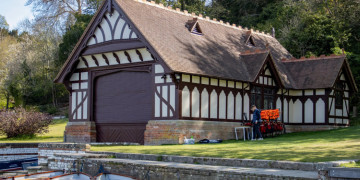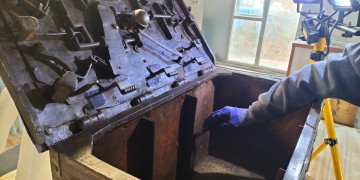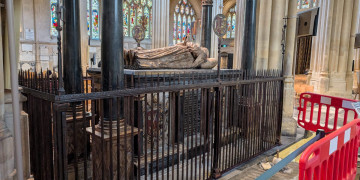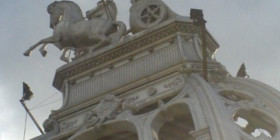Guide: Traditional Leaded Lights, Care and Repair
Leaded light windows are becoming increasingly rare so retaining them is certainly of worth. Looked after correctly, leaded lights can last centuries, so routine maintenance is essential for their conservation.
Leaded lights are one of the oldest techniques for glazing still in use today. Looked after properly, leaded lights can last hundreds of years, so routine maintenance is essential for preservation.
This guide aims to give you a brief outline of the history of leaded lights in the UK and traditional glass, and production techniques, advise on a typical maintenance routine and describe likely restoration processes where necessary.
Introduction
Leaded lights are of fairly simple construction. Small panes of glass (quarries) are joined together using lead cames which are shaped like an H-section to hold the pane. Lead’s material properties are soft, flexible and affordable. This made it a perfect choice for early glazing.
Copper, brass or lead ties are soldered into the rear of the cames, which are then fastened to the main window bars to provide structural strength to the panels. Glazing cement (traditionally consisting of linseed oil, whiting, lamp black and white spirit) is installed under the flanges of the lead came to secure the quarries in place. The leaded window unit was then installed into stone, timber or metal surrounds using traditional putty.
This glasswork technique came about due to limitations in early glass production. Only small pieces of glass could be produced, and as such a technique needed to be developed to create larger glazed spaces.
Traditional leaded light windows differ slightly from stained glass. Though the came glasswork technique allowed for both to be produced. Stained glass windows, commonly found in ecclesiastical settings and grand houses, included extra production processes such as painting and firing.
This time-consuming design process was far too expensive for domestic settings, and so traditional plain leaded light windows, have been an architectural feature in UK homes for centuries.
As glass production techniques developed in the 17th century and larger panes of “crown” glass were produced instead of traditional broad or cylinder glass, cutting lights into diamond shapes minimised waste, and so remained popular.
The development of sash windows in the 18th century led to leaded lights falling out of fashion in domestic settings, but popularity returned with Gothic Revival architecture in the late 19th century, the Art Nouveau period pre-World War I and after WWII, when mock Tudor style was prevalent.
Interestingly, medieval lead came work windows are sturdier than those of their successors in the 19th and 20th centuries. The lead composition has changed over time, initially, by removing other metals to make “pure” lead and then again with less lead during the World Wars. It wasn’t until the 70s that restoration lead was developed, its composition based on that of its medieval predecessor.
Care and Maintenance
Keeping a close eye on leaded light windows and developing a cleaning routine will of course improve longevity. The came work, the glass itself and the casement frames need to be examined regularly. If in doubt, seek professional advice from a leaded light restorer.
Regular Inspections
A little movement is to be expected in old leaded lights and is not a major concern. However, prominent bows, raised sections, buckles or bellies of the whole window can result in original glass work breaking and failure of the lead cames.
Things to look out for:
- Each piece should be flat, smooth and straight at the edges. Check for bowing, distortion or furrows near the edges
- Check that the ties are attached to both the panel and the saddle (window) bar. Detached ties can lead to movement and glass breakage
- Check the window frames periodically for corrosion and deterioration of timber. The inherent expansion of oxidised metals and movement of timber or stone surrounds can create serious issues for leaded lights.
- Ensure the putty or cement holding the quarries into the came-work is still sound and provides a weather-tight seal
Cleaning and Maintenance
Leaded lights should be cleaned gently both internally and externally with de-ionised water and cotton wool. Don’t scrub or use any abrasive cleaning products or cloths as historic glass is very vulnerable to scratches.
Casement window frames can be cleaned gently with soft cloths or a brass brush. Do not use any abrasive cream or solvents, and ensure you dry the metalwork completely after cleaning.
Typical Restoration Techniques
As always, preserving the existing fabric and restoration with traditional techniques are favoured. Old glass is becoming increasingly rare. Fortunately, saving original glass from run-down lead cames is usually achievable so retaining it is certainly worth it.
Where replication is necessary, replacement with historic, traditionally crafted glass will depend primarily on the historic context of your leaded lights.
The same applies to lead work, which can usually be repaired or retained if it is still soft and pliable. Even if the leaded lights do not need re-leading, the boundary lead will sometimes need replacing. In most cases, the cement or putty will also need repairing or replacing entirely. For more information on restoration techniques and the historical context of lead in architecture, have a look here.
Click below for guides on other architectural metalwork features:
- Caring for architectural cast iron
- Maintaining wrought ironwork
- Cast iron rainwater system care
- Maintaining metal casement windows
 The Boat House, Cliveden, National Trust
Dorothea carried out the conservation of the 160 year old iron roller shutter.
The Boat House, Cliveden, National Trust
Dorothea carried out the conservation of the 160 year old iron roller shutter.
 Restoration of 17th century strong box
It not very often you get the opportunity to restore an object with so much history and stories to tell. The strong box forms part of the C. Hoare & Co history and the transfer of gold and coins across oceans and dirt roads.
Restoration of 17th century strong box
It not very often you get the opportunity to restore an object with so much history and stories to tell. The strong box forms part of the C. Hoare & Co history and the transfer of gold and coins across oceans and dirt roads.
 Bishop Montague's Tomb, Bath Abbey
Dorothea Restorations had the privilege of working with Peter Meehan ACR on the restoration of the historic railings around the Montague Tomb. The conservation of these railings form a part of the significance the Abbey has played in Bath's long heritage and the history of the Abbey.
View All
Bishop Montague's Tomb, Bath Abbey
Dorothea Restorations had the privilege of working with Peter Meehan ACR on the restoration of the historic railings around the Montague Tomb. The conservation of these railings form a part of the significance the Abbey has played in Bath's long heritage and the history of the Abbey.
View All











